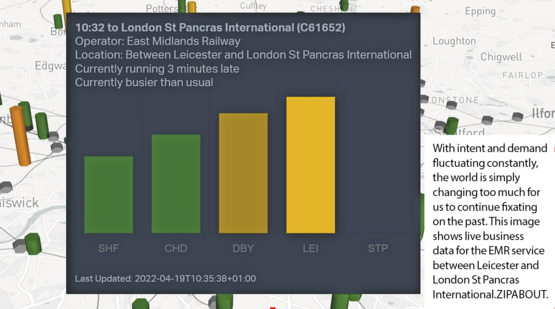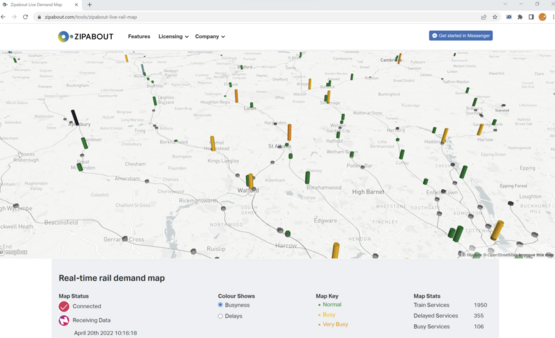For too long, historic data has been the deep-rooted foundation on which transport networks have based their everyday decisions.
But with the mindset around data and storage dramatically changing in the real world over the past few years, the transport sector has fallen behind and failed to keep up with these discernible shifts.
Although it’s been almost 20 years since the advent of AdTech and personalisation, the industry is still consumed by historic data patterns and mobile data. Ultimately, this is the landscape that needs to change in order for us all to move forward with an effective solution that fundamentally improves the entire passenger experience.
With intent and demand fluctuating constantly, the world is simply changing too much for us to continue fixating on the past. Instead, we should look to the future and accelerate transport development by turning our attention to forecast data.
The importance of AdTech
We know that AdTech has long survived based on what a person will do, as opposed to what they have done - that is the basis on which infrastructure and ecommerce is planned.
But in the transport industry, what will happen on a future or real-time scale is often informed by what has happened previously. Transport patterns must be broader than this in order to appropriately inform passengers of their journey.
Too many transport organisations are generalising their usage patterns based on incorrect historic data. For example, it’s easy to assume that a public holiday will result in a busier travel period. But this is not specific to a particular day and does not take into account a range of crucial elements that may have an impact on these assumptions, such as weather patterns and passenger intent. This leads us to take an oversimplified and narrow view of what is a far more complex system.
With these sweeping generalisations, data that is mapped against typically busy or quiet periods is not being accurately predicted. This results in transport operators being misinformed, services becoming busy, and passengers feeling dissatisfied.
This was especially important during the height of COVID-19, as transport operators were largely unable to respond effectively to the daily fluctuations in demand. By relying on mechanisms that only considered previous ticket sales and passenger numbers, they were being fed forecasts that were not only misleading, but which were also causing big problems in the face of an ongoing crisis.
Historic data can no longer be used to predict future demand. People’s travel habits have adapted, and the way they prefer to travel has changed, too.
That’s why we need to focus more on personalisation and determine how many people intend to use a particular service. With this information to hand, operators can stagger a person’s journey, inform them of overcrowding in advance, and provide alternative options should they need them.
Too reliant on mobile data
In addition to historic data playing a lesser role in our everyday transport assessments, it’s also worth looking at how reliant we’ve become on mobile data.
Up to now, mobile data and location tracking have been paramount when informing decisions, and this misguided view has created a wave of fog that has clouded the judgement of those at the forefront of it all.
In reality, mobile data tells you nothing concrete about why people are travelling, where their final destination is, or what their personal preferences are when it comes to transport.
For decades, we’ve heard that “mobile data is the only way forward”, but it doesn’t tell you what people will be doing later today, next week, or the week after. Consequently, the real route forward is in prediction data and calibrating it to suit the individual. We need all of these elements to work together to make things effective.
This is no secret, of course, with tech giants such as Google, Apple and Uber making it clear that historic models and ticket sales based on mobile data largely mean nothing.
As the tech and transport industry tries to keep up with behaviour shifts and passenger intent, mobile data continues to lose ground in the smart city space and fails to offer the resolution that we need.
But by combining all of our sources into something that truly services the railway, we can collectively work together and stop attempting to reinvent a host of single sources that work against each other.

Personalisation is everything
There is no doubt that personalisation is already at an all-time high. Just one look at Amazon or Google will tell you that we’re at a point in time where machine learning is entirely accessible, yet the transport sector is still falling behind in this race.
Historic ticket sales show what passengers did based on the options they had in front of them at the time, which means we’re wrongly recording real decisions that someone has made based on very limited options. So, the data on which we’re basing everything - from timetabling to route options - is vastly different to what that passenger actually wanted.
Data needs to show what combinations of events create an accurate, authentic portrayal of passenger patterns. With historic data, we cannot possibly begin to solve predicaments such as:
■ How many people will a late train effect?
■ Which passengers will need alternative route options?
■ Are they travelling for several hours and in need of refreshment?
We need a number of different elements at our fingertips to predict transport demand patterns appropriately. And the only solution around this is understanding intent.
This includes using real-time machine learning models to deliver personalised information to passengers that can help to intelligently spread passenger load across the network and minimise the impact of incidents.
Utilising data for post-COVID recovery
Intent data proves itself valuable in not only understanding how people use transport, but also at encouraging people back to the retail and the hospitality sector.
This is particularly vital in a post-COVID world where businesses are relying on customer insights to build themselves back up again. With intent data, we can use contextual targeting to highlight the needs of customers to businesses and support them in offering personalised solutions to those customers.
In essence, accuracy relies on collaboration. Now is the time for a well-refined series of data source techniques from AdTech and other industries to make its mark in operational planning. Only when we get that collaboration right will we begin to build routes that service demand. This in turn will be the catalyst to an effective transport network for both urban and rural areas of the UK.
This type of data is something that we’re already collecting at scale and is something that is readily available at no charge. It cannot and should not be ignored, and we will not be successful at “building back better” without it.
Fortunately, positive moves are continually being made in this space - forecast and intent data is now being used to power personalised messaging for the most forward-thinking train operating companies, such as LNER, East Midlands Railway and c2c.















Login to comment
Comments
No comments have been made yet.